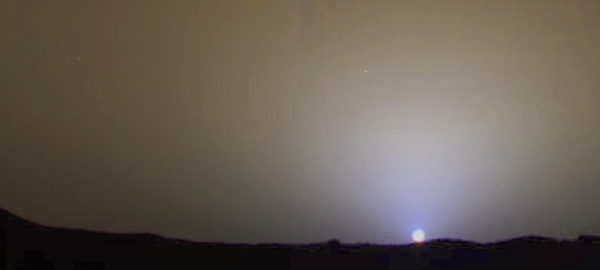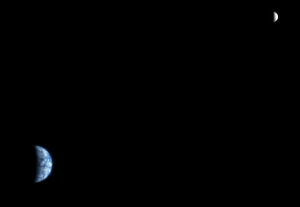SkyCaramba weekly astronomy blog for the week ending March 24, 2012
It’s summertime in the northern hemisphere of Mars. The solstice will be on March 30th at 04:20 UT Earth time. Let’s imagine what it would be like to look at the sun and other solar system objects from Mars at this time.

The Martian atmosphere scatters sunlight ways we don’t see on Earth. Clear midday skies are yellow-brown. Clouds can make the sky purple. When the sun’s rising or setting, the sky is red away from the sun and blue close to it. But nighttime skies are black just like on Earth. Mars rotates once in 24 hours, 40 minutes.
Right now, from Mars, Earth is a morning object. At 0 magnitude, it’s brighter than almost everything else in the sky. Viewing it in a telescope, you may be able to see

its moon 0.2° away. Both appear like the last quarter moon from Earth. Constantly changing cloud patterns indicate a complicated atmosphere on that inner planet.
Mercury rises a bit later, but it’s even harder to see in the dawn on Mars than on Earth. And right now’s not a good time to try. It’s lost too much in the sun’s glare.
If you could see the constellation lines in the sky, the sun would be in Aquarius but almost on the line with Pisces. The sun will be farthest north at this time. Just like on Earth, there are places on Mars so far south the sun doesn’t rise for weeks or months around the northern solstice.
Very shortly after sunset, you’ll spot Venus in Pisces. A little further west of it, Jupiter shines at the same brightness in Aries. We’re used to Venus being so much brighter than Jupiter.
Saturn is in Virgo from Mars, about the same as it appears from Earth right now. Mars and Earth are about the same distance from the ringed planet right now, so the telescope view won’t let you see a much bigger ring span.
Mars has two moons. The names Phobos and Deimos mean fear and panic. They were the dogs of the god Mars. Both moons are so small, from the surface of Mars they look like dim dots among the stars. They’re so dim, you need a telescope or binoculars to see them.
Deimos is the farther and smaller one. It orbits the red planet in just a little longer time than it takes for Mars to rotate once. While the starry background moves overhead, Deimos almost appears to hover in place. It actually slowly moves from east to west. It will spend several days above the horizon, then several days below it. You’d have to travel extensively on Mars to keep it in sight every day.
Phobos is so close, it orbits Mars three full times and part of a fourth in one Martian day. You would see it rising in the west and setting in the east less than four hours later.
From time to time, a Martian observer could see Mercury, Venus, and Earth cross the disk of the sun. That’s called a transit. Earth transited the sun as seen from Mars in 1984. Arthur C. Clarke wrote a book in which a marooned astronaut looked back at Earth from Mars during that transit as he took his last breaths.
I hope you get to take plenty of big breaths as you watch the skies and wonder how they may look from other planets. ¡SkyCaramba!